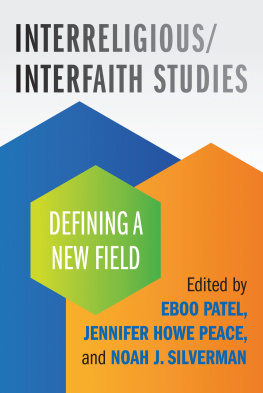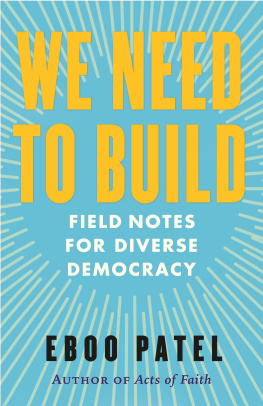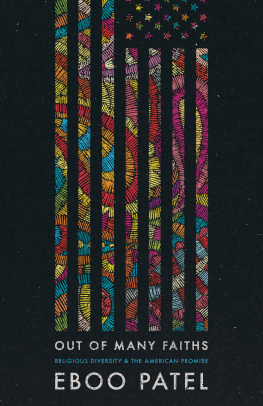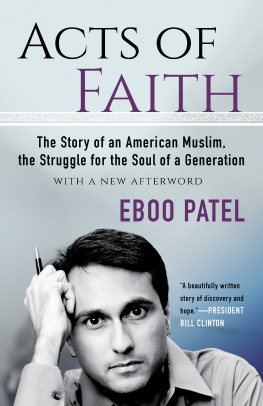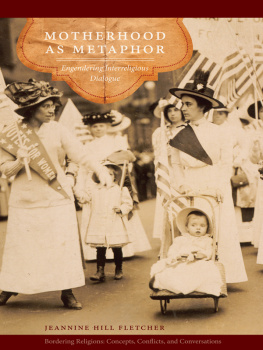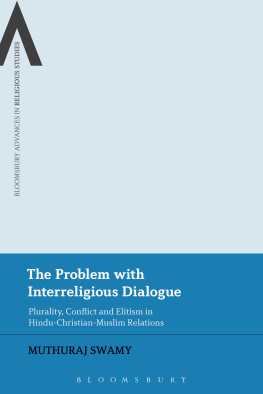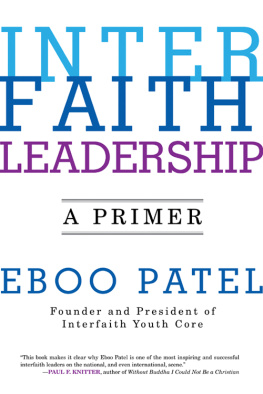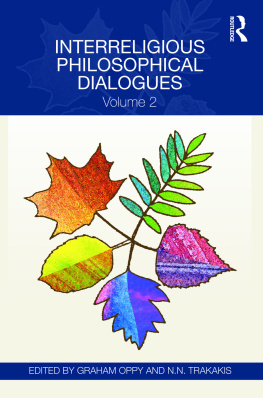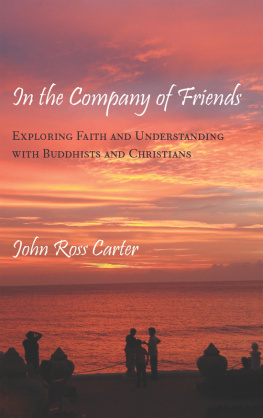Table of Contents
Pagebreaks of the print version
Guide

To the memory of Brendan W. Randall (May 8, 1966July 9, 2017), friend, colleague, and scholar and practitioner of interfaith studies par excellence
INTRODUCTION
Eboo Patel, Jennifer Howe Peace, and Noah J. Silverman
You might say that this volume had its origins in a generic hotel conference room in San Diego in 2014 during the annual gathering of the American Academy of Religion (AAR). Diana Eck, senior scholar at Harvard, had wondered out loud if interreligious studies had something to offer not only in terms of content (examining what people are doing interreligiously) but also in terms of methodology, favoring an active learning approach over the default academic lectures. Murmurs of assent broke out among the eighty or so people gathered for the session titled Toward a Field of Interfaith Studies: Emerging Questions and Considerations and hosted under the auspices of the AARs Interreligious and Interfaith Studies Unit. The panel, which included coeditors Eboo Patel and Jennifer Howe Peace, was organized around three questions: What personal history brings you to your place in interfaith studies? What are the challenges or tensions in this emerging field? (Or, as Patel put it, What keeps you up at night?) And, from your perspective, what are some of the defining moments in the current evolution of this (sub)field?
Eck, who twenty-five years ago founded the Pluralism Project, an initiative that foreshadowed much of what has come to be called interreligious or interfaith studies, noted that she saw endless opportunities for real research in this new field. There is a lot going on in the world that has to be brought into focus, she pointed out. Throughout the session, people were feeling their way toward what this field was, could be, or should be. There is no frame for what we are doing, said one participant. He elicited nervous laughter when he jokingly commented, Im pretty sure Im going to be fired for what I did here today.
Patel observed that a distinctive contribution of the AAR was to offer direction, depth, and definition, along with rigor as this field emerged. He quoted from his recent article Toward a Field of Interfaith Studies:
Scholars from a range of fields have long taken an interest in how people who orient around religion differently interact with one another.... As the activity in this area increases, one crucial role for the academy is to give some definition to what is clearly an emerging field of research, study, and practice. Another role is to recognize the importance of training people who have the knowledge base and skill set needed to engage religious diversity in a way that promotes peace, stability and cooperationand to begin offering academic programs that certify such leaders.
Further elaborating his hopes for the field, Patel named five civic goods associated with interfaith work: reducing prejudice, strengthening social cohesion, building social capital, strengthening the continuity of identity communities, and, finally, creating binding narratives for diverse societies.
Peace argued that interfaith studies is more than an academic exercise, given the reality of religiously motivated violence, bigotry, and a lack of mutual understanding across religious traditions. In her definition, interfaith studies is a field that values scholarship accountable to community, the dynamic link between theory and practice, and the centrality of relationships at every level (from subject matter to methodology and motivations).
Other scholars weighed in. Interreligious studies is a subfield of religious studies, said panelist Jeanine Diller. This was clear in her context at a large secular university and mirrors Kate McCarthys argument in her chapter for this book. Barbara McGraw (also a contributor to this volume) noted that in her setting at Saint Marys College of California she defines this as an interdisciplinary field under the rubric of leadership. Her model includes a focus on (1) leadership in an organization; (2) communication and dialogue; (3) identity and bias; and (4) religious literacy.
John Thatamanil, associate professor of theology and world religions, mentioned that his institution, Union Theological Seminary, had added interreligious engagement as their newest field within theological education. He outlined Unions approach, which includes theory from comparative religious studies, in-depth knowledge of a particular tradition other than ones own, and appreciation for cultivating dispositions that promote interreligious understanding (based in part on Catherine Cornilles work).
Oddbjrn Leirvik, who wrote Interreligious Studies: A Relational Approach to Religious Activism and the Study of Religion, suggested three categories for the range of concerns we were discussing: (1) interreligious worka broad term referring to practical efforts; (2) interreligious education or formation work, which Leirvik noted is less common in Europe than in the US; and (3) interreligious studies, which he described as being focused on studying interreligious dialogue as well as broader efforts related to building interreligious relations. He also noted that an important critical contribution of this area involves attending to the power relations and gender dynamics that are part of interreligious engagement. (This last point is taken up by several contributors to this volume, including Elizabeth Kubek and Jeannine Hill Fletcher.)
The sessions conversation continued with animated dialogue about goals and definitions, both compatible and competing. All of it underscored a key concern articulated at the outset of the panelthat we lack a current consensus about the nature of this emerging field. What does it mean to do this work well?
Sixteen months later, in March 2016, over one hundred faculty members from across the United States came together for a conference at California Lutheran University to discuss curricular programs in the emerging field of interfaith and interreligious studies. Robert Jones, a sociologist and the CEO of the Public Religion Research Institute, was one of the keynote speakers. He caught up with the three coeditors of this volume after one of the conference sessions and commented, Well, interfaith studies is certainly a thing.
As recently as even five years ago, that statement would have been unlikely. Indeed, when Patel published his article calling for the creation of an academic field of interfaith studies in 2013, the argument was almost entirely speculative. Five years later there are enough facts on the ground within the academy that are referred to as interfaith and/or interreligious studies to constitute a discernible thing. An incomplete list includes
The AAR approved a new unit in 2013, cofounded and cochaired by Jennifer Howe Peace, one of the coeditors of this volume, focused on Interreligious and Interfaith Studies. The group receives between sixty and eighty proposals per year and regularly draws seventy-five to ninety participants to each of its sessions.
Building on the momentum of the AAR group, in 2017 an affiliated Association of Interreligious/Interfaith Studies was launched by Peace in conjunction with the annual AAR gathering held that year in Boston.
There are now more than one hundred undergraduate courses on college and university campuses that focus on interfaith topics.
Tenure-track faculty positions in interfaith studies (or labeled similarly) now exist at Andover Newton Seminary, Candler School of Theology, Claremont School of Theology, Regis University, and Villanova University, with similar positions at other undergraduate and graduate institutions currently under development.

